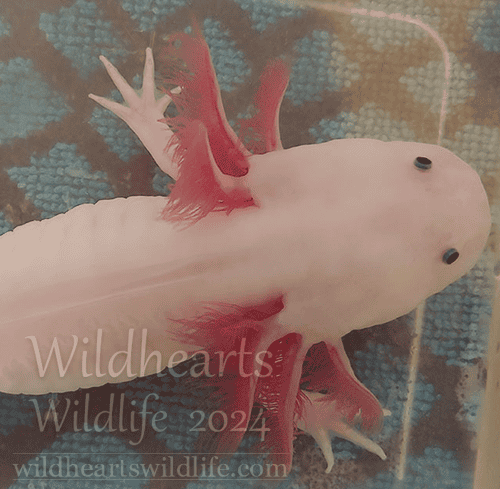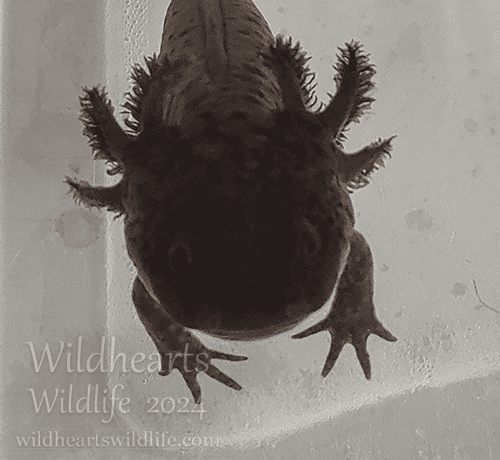One of the biggest considerations when taking in a new exotic pet is where he or she is going to live. Providing our pets with proper enclosures can go a long way towards helping to ensure both their mental and physical health. When it comes to aquatic critters, tank size is especially important. Our axolotls live their entire lives in, basically, boxes of water. As far as aquatic pets go, axolotls can get pretty big and are also messy. They also, as amphibians, can be especially sensitive to water parameters. The presence of toxins within their environment, yes even natural toxins such as ammonia, can be detrimental to your axolotls’ health.
Besides learning how to properly cycle our axolotls’ aquarium, selecting an appropriately sized home (aquarium) for our slimy friends is super important.
Bigger is Always Better!
Well, I mean…when it comes to aquariums.

Think of how much space your axolotl would have if they were living out in the wild – an entire lake! Axolotls are not typically the most active of creatures, but being able to provide them with everything they need, such as multiple hides, room to swim around, and the opportunity to explore, is much easier in a larger aquarium.
A larger tank will mean a larger water volume. That means more water to help dilute any toxins that may find their way into your aquarium. Nitrates, for example, a normal toxin produced by the nitrogen cycle, will build up to a dangerous level much faster in a small aquarium than it would in a large one.
A larger aquarium for your axolotl will mean less maintenance required from you! When toxins build up slower, you don’t have to perform water changes to remove them as often.
But, of course, we can’t offer our indoor axolotls entire lakes to swim around in. There has to be some middle ground. What is an appropriate tank size for an axolotl? The recommended tank size for axolotls has changed over time. For curiosities sake, I’m going to go over both new and older tank size recommendations. Some keepers still choose to follow older guidelines, although I personally feel it’s important to stay on top of new developments when it comes to caring for our animal companions. Care standards often improve over time, as we learn more about a species and how to best keep them healthy in captivity.
Old Axolotl Tank Size Standards
The old axolotl care standards called for a 20-gallon aquarium for a single axolotl, then an additional 10 gallons per each additional (same sex) axolotl kept in the same tank. So if you wanted to keep three axolotls together, for example, you’d need a 40-gallon aquarium – 20 gallons for the first axolotl then an additional 10 gallons added to that for the additional two.
Newer Axolotl Tank Size Recommendations
However, newer recommendations call for larger aquariums. Most keepers more up-to-date on modern care will recommend minimum aquarium sizes ranging from 29 to 40 gallons for a single axolotl, then an additional 20 – 30 gallons over that per additional axolotl kept in the same tank. If we start off with 40 gallons for a single axolotl, that would mean going with an 80 – 100 gallon tank for 3 axolotls.
What Do I Personally Recommend?
Well, I already said…bigger is better. Especially if you are new to keeping aquatic animals, a larger aquarium will give you a bit more wiggle room when it comes to maintaining proper water parameters. I’m also big on offering our exotic pets as much space as we can. Axolotls may not be the brightest animals out there, but that doesn’t mean they don’t appreciate having more space. In my opinion, offering plenty of space for them to engage in natural behaviors and to be provided with mental stimulation is important. Keeping in mind that mental stimulation for an axolotl will typically mean providing them with things like multiple hides, live plants, plenty of space to swim around, bubblers, and opportunities to forage naturally for food.
Factors to Consider
Like many things when it comes to caring for living beings, things like what tank size to use isn’t always a “one size fits all” situation. While I would always recommend giving your axolotls large tanks if you can, I certainly agree that there are some situations where a smaller aquarium may work out ok too. Here are some factors I think owners should keep in mind when trying to determine what tank size is best for their individual axolotl:
- Your Axolotl’s size. Not all axolotls will reach the same adult size. I think my axolotls demonstrate this well. I have one male, Bubbles, who is huge! My other male, Locke, is smaller even than my two females. There’s no way I’d feel comfortable keeping Bubbles in a smaller aquarium, but I actually think Locke would do fine in a 20-gallon.
- Your setup. Keeping live plants in with your axolotl can help keep nitrate levels in check, as plants use nitrate as fertilizer. Your tank setup can also somewhat depend on what type of hides and other things you want to keep in your tank. If you prefer, or your axolotl needs, huge hides then you’ll want to go with a larger tank to accommodate.
- Your dedication to water maintenance. Smaller tanks will require more maintenance. This will mean checking parameters more often, as well as performing more frequent water changes. Some owners are fine with this, even enjoy it, and so may be able to get away with keeping their axolotl in a smaller tank. If you’re the type who is prone to skipping a water change every now and again, go with a bigger tank.
- 1 axolotl or more? Tank size becomes more important if you decide to keep multiple axolotls together. Not only will more axolotls make your water dirty faster, but they’ll need plenty of space to be able to get away from each other if they want (or need) too.
Not (Necessarily) One Size Fits All

Use your judgment on what will work best for you and your pets. I have used the older tank size recommendations to keep axolotls in the past and had them do well. But I’m also the type to stay on top of monitoring my water quality, and the axolotls in question were smaller females. These days, I very much subscribe to the ‘bigger is better’ way of thinking when it comes to housing animals in general.
Don’t beat yourself up if you have to house your axolotl in something smaller than a 40-gallon for now. Stay on top of maintenance and upgrade when you can. One trick I like to tell people who tell me they can’t afford huge aquariums is that axolotls don’t necessarily need traditional glass aquariums. You can cycle water in basically any type of container that is animal-safe and holds water. I’ve used stock tanks for my axolotls in the past and have talked to owners who have successfully used things like large plastic totes, and baby pools. Get creative if you want (or have) to! At the end of the day, there’s no single “right” way to keep most living things. We have to do what we can to give our individual axolotls the best lives possible.
———————
Unfortunately, Wild Hearts Wild Life has been dealing with content scrappers stealing our content and posting it to other websites without permission. If you’re seeing this article posted anywhere besides wildheartswildlife.com it means you are seeing it on a content scalper’s site. Please consider contacting us to let us know, and stopping by to visit on our actual site! Thank you!
